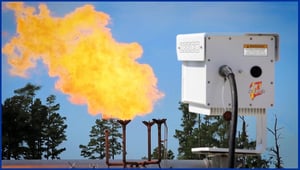新的直接火焰监测技术
政府对炼油厂、天然气加工厂、石化制造商和OEM供应商的规定不断变化,他们需要不断调整以满足要求。在全球范围内,各种设施因其对全球环境的排放贡献而受到严格审查,并且不断被要求达到更严格的标准。自成立以来,美国环境保护局(EPA)一直积极参与各种火炬系统的执法行动,以减少火炬的排放。
Abstract
Known shortcomings of current flare monitoring methods plus new EPA standards drove the need to develop a new direct flare combustion efficiency (CE) measurement and monitoring method – a technology that directly, autonomously, and continuously monitors flare performance in real time. This patented method, known as VISR, or Video Imaging Spectro-Radiometry, utilizes a multi-spectral infrared (IR) imager to simultaneously measure the relative concentrations of combustion products, carbon dioxide (CO2), and unburned hydrocarbons (HC) at the pixel level. Directly monitoring flare CE eliminates inaccuracies associated with the current practice of monitoring indirect parameters (heating value, velocity, etc.). Because VISR devices can operate autonomously, no aiming or manual data reduction is required. Remote measurement removes the need for contact with corrosive process streams, making VISR devices less costly to maintain and operate over time. This paper will discuss the VISR technology and how it can be used to generate continuous, real-time data on CE and smoke, allowing operators to optimize flare performance in real time.

FlareGuardian
To take full advantage of the advancements made by VISR technology, Zeeco has produced a VISR-based product called FlareGuardian to meet the demand for an efficient, accurate, and compliant direct flare monitoring system.
Discussion
Current measurement methods possess certain pitfalls, such as high capital cost, extensive servicing of all components, constant re-calibration of devices, exposure to corrosive process conditions, and higher labor investment to ensure compliance with mandated regulations. Also, since the EPA RTR rule is accompanied by time-dependent monitoring constraints, a problem is created when striving to comply while using methods that do not provide real-time results. Surrogate parameter measurement is dependent on multiple process components to report data in a multitude of timeframes, which can create prohibitive delays in obtaining results for relative flaring performance. During this composite time delay, flaring process conditions could change dramatically and possibly negate any compliance corrective action, a problem which is not experienced by the real-time data reporting provided with VISR devices. FlareGuardian simplifies monitoring and reduces the involvement of plant operators to ensure compliance and flare efficacy. Currently, the EPA RTR rule has been derived to govern flaring applications in the US refining industry. With the compliance deadline approaching in the near future, refineries will be required by law to meet these evaluation parameters regardless of the technology employed. More extensive coverage of operations will be in the line of sight for future regulation, such as chemical plants, midstream operations, and further upstream exploration and production efforts. As these regulations progress, so should the technology behind remaining compliant, such as developments like the VISR-based FlareGuardian system.
总结
Available data supports that the use of VISR technology has been validated and will soon emerge not only in the industry but also with regulatory agencies as the best available technology for flare monitoring. VISR-based products such as FlareGuardian will enable operators to reduce flaring emissions, improve flare performance, and troubleshoot flaring systems, giving them a means to control CE and optimize performance in real time.
下载技术文件